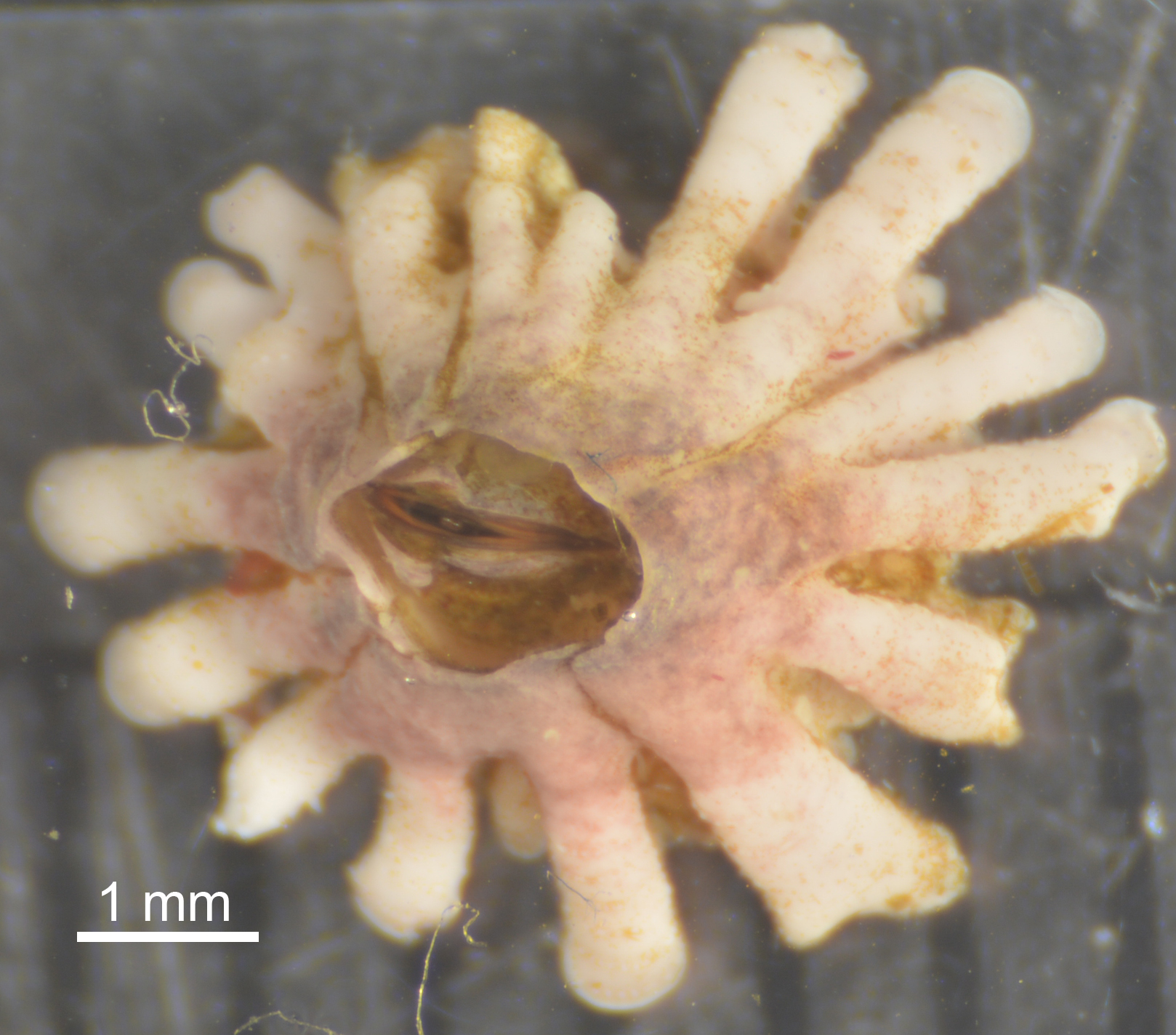Faculty of Science, Hokkaido University, Sapporo 060-0810, Japan
Material and Methods
A barnacle was obtained from mussel beds at Oshoro bay, Hokkaido, Japan, about 43°12′N, 140°51′E, by Yoshitake Sakai and Yudai Suzuki, identified as Semibalanus cariosus (Pallas, 1788) by Hiroshi Kajihara, photpgraphed and fixed in 99% EtOH by Takumi Onishi. DNA was extracted from a part of body using the silica method (Boom et al. 1990) with some modifications. Extracted DNA was dissolved in 30 µl of deionized water and has been preserved at –20°C. Remaining morphological voucher specimen has been deposited at the Hokkaido University Museum under the catalogue number ICHU 2122034 (contact: Hiroshi Kajihara, kazi@mail.sci.hokudai.ac.jp).
Amplification of mitochondrial cytochrome c oxidase subunit I gene (COI) using LCO1490 (5′-GGTCAACAAATCATAAAGATATTGG-3′) and HCO2198 (5′-TAAACTTCAGGGTGACCAAAAAATCA-3′) (Folmer et al. 1994) was performed by a thermal cycler,2720 Thermal Cycler (Applied Biosystems), in a 20-µl reaction volume containing 1 µl of template total DNA (approximately 10–100 ng) and 19 µl of premix made with 632-µl deionized water, 80-µl Ex Taq Buffer (TaKara Bio), 64-µl dNTP (each 25 mM), 8-µl each primer (each 10 µM), and 0.1-µl TaKara Ex Taq (5 U/µl, TaKara Bio). Thermal cycling condition comprised an initial denaturation at 95°C for 30 sec; 30 cycles of denaturation at 95°C for 30 sec, annealing at 45°C for 30 sec, and elongation at 72°C for 45 min, and a final elongation at 72°C for 7 min.
The PCR product was purified with the silica method (Boom et al. 1990). Both strands were sequenced with a BigDye® Terminator v3.1 Cycle Sequencing Kit (Applied Biosystems) following the manufacturer's protocol, using the same primer set as the initial PCR amplification. Sequencing was performed with ABI Prism 3730 DNA Analyzer (Applied Biosystems). Chromatogram and sequence data were operated with MEGA v5 software (Tamura et al. 2011).
Results
Phylum Arthropoda
Infraclass Cirripedia
Family Archaeobalanidae Newman and Ross, 1976
Genus Semibalanus Pilsbry, 1916
Semibalanus cariosus (Pallas, 1788)
[Japanese name: chishima-fujitsubo]
(Fig. 1)
A total of 641 bp of partial sequence of COI was determined from Semibalanus cariosus (Pallas, 1788) (see Appendix). However, a nucleotide BLAST search (Altschul et al. 1997) at the NCBI website (https://blast.ncbi.nlm.nih.gov/) showed that our sequence was 99% identical with those of the prawn Trachypenaeus curvirostris, e.g., KP176652 (Han et al. unpublished). We were puzzled and at a loss how to interpret these results, but this must have happened as a consequence of contamination, either in the field or during the lab work.

Fig. 1. Semibalanus cariosus (Pallas, 1788), ICHU 2122034, photograph taken in life.
References
Altschul, S. F., Madden, T. L., Schäffer, A. A., Zhang, J., Zhang, Z., Miller, W., and Lipman, D. J. 1997. Gapped BLAST and PSI-BLAST: a new generation of protein database search programs. Nucleic Acids Research 25: 3389–3402.
Boom, R., Sol, C. J. A., Salimans, M. M. M., Jansen, C. L., Wertheim-van Dillen, P. M. E., and van der Noordaa, J. 1990. Rapid and simple method for purification of nucleic acids. Journal of Clinical Microbiology 28: 495–503.
Folmer, O., Black, M., Hoeh, W., Lutz, R. and Vrijenhoek, R. 1994. DNA primers for amplification of mitochondrial cytochrome c oxidase subunit I from diverse metazoan invertebrates. Molecular Marine Biology and Biotechnology 3: 294–299.
Tamura, K., Peterson,D.,Peterson,N.,Stecher,G., Nei, M. and Kumar, S. 2011. MEGA5: Molecullar Evolutionary Genetics Analysis usingmaximum likelihood, evolutionary distance, and maximum parsimony methods. Molecular Biology and evolution 28: 2731-2739.
Appendix
COI sequence (620 bp) from ICHU 2122034 identidied as Semibalanus cariosus (Pallas, 1788).
TTTATCTTCGGAGCTTGAGCTGGGATAGTGGGTACCGCCTTAAGTTTGATTATTCGAGCTGAACTAGGACAACCAGGTAACCTTATTGGAGATGATCAAATTTACAATGTAGTAGTCACTGCTCATGCCTTTGTAATAATTTTCTTTATAGTTATACCCATAATGATCGGAGGATTTGGAAATTGATTAGTCCCGCTTATATTAGGAGCCCCTGATATAGCATTCCCCCGAATAAATAATATAAGATTCTGGCTTTTACCTCCCTCTCTAACTCTCCTTCTCTCAAGAGGTATAGTCGAAAGTGGGGTAGGAACAGGGTGAACAGTATACCCTCCCTTGGCAAGTGGAATCGCACATGCTGGGGCATCAGTAGATATAGGAATCTTTTCTCTTCATTTAGCAGGAGTCTCATCAATCCTAGGGGCTGTAAATTTTATAACTACAGTAATTAATATACGATCCGCAGGAATAACAATAGACCGTATACCCTTATTTGTTTGATCAGTTTTTATTACTGCCCTTCTCCTACTTCTCTCATTACCAGTATTAGCAGGGGCTATTACGATACTTTTAACTGACCGAAACCTTAATACATCTTTCTTTGACCGCGGCGGGAGGGGGTGACCCCATCCTAACCAAAC